In the last decade MOLA published over 90 academic and popular books and manuals, and has developed processes to ensure the highest standards. Publications include both English Heritage- and developer-funded work but have been joined by significant work for other clients, who are using MOLA as a publishing outlet for their own work.
MOLA's Monograph and Studies Series have in general developed a common structure: an introduction; a chronological narrative describing the site sequence interwoven with the specialists’ evidence; thematic chapters; conclusions; and appendices with supporting data which cater for the specialist reader; these data are supplemented by CD-ROMs and online resources. The integrated approach requires a high level of collaboration and dialogue among the project team, and a focus on strong research aims within regional and national research frameworks and strategies. The research aims are set out before fieldwork begins and are revised at the assessment stage. This approach is underpinned and facilitated by their in-house team, supplemented by experts based in academic institutions. It also requires high levels of IT expertise in their developing relational database and geographic information system (GIS). Quality assurance is essential, supported by MOLA's in-house Managing Editor. Finally the graphics and photography teams ensure high-quality illustrations and products that convey information with maximum clarity. The success of the integrated approach and the quality of the publications is conveyed in many positive reviews written by peers in archaeological journals and news items. As well as the many books MOLA also submit numerous articles to local, regional and national peer-reviewed journals. These papers are just as important to the publisher and their clients, and deliver the results of archaeological work to the target audience as required by both client and curator.In the last decade MOLA published over 90 academic and popular books and manuals, and has developed processes to ensure the highest standards. Publications include both English Heritage- and developer-funded work but have been joined by significant work for other clients, who are using MOLA as a publishing outlet for their own work.
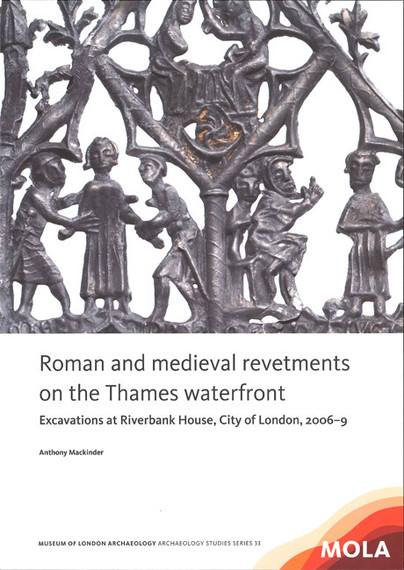
Format: Paperback
Pages: 137
ISBN: 9781907586309
Pub Date: 02 Feb 2015
Description:
Archaeological investigations were carried out in 2006–9 on the north bank of the River Thames at Riverbank House, City of London, just upstream of the modern London Bridge and its medieval predecessor, in the heart of the medieval port. An extensive watching brief had taken place on the site in the early 1980s (the Swan Lane car park), but these new excavations were in undisturbed areas around the perimeter. A 2nd-century AD revetment and part of the late Roman riverside wall were recorded, while a sequence of timber revetments, some dated by dendrochronology, witness the growth of the medieval port from the 12th to the 15th centuries.
Fragmentary building remains relate to medieval and post-medieval tenements, and pipes from a 16th- or 17th-century ship’s pump were found reused as a drain. Characteristically, foreshore deposits and reclamation dumps infilling the medieval waterfronts produced many well-preserved finds, particularly leather and metal objects. The latter include tools, domestic items, cloth seals and a number of religious and secular badges. A rare and unusual find was a devotional openwork panel relating to the life and death of Thomas, Earl of Lancaster, who was executed on 23 March 1322 by Edward II. Remains of plants used in dyeing support the documented importance of the local cloth-finishing industry.
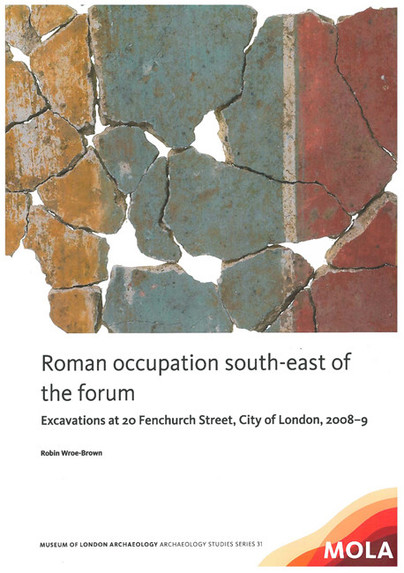
Format: Paperback
Pages: 128
ISBN: 9781907586248
Pub Date: 13 Jan 2015
Description:
Excavations near the Roman forum on Londinium’s eastern hill (modern Cornhill) have revealed archaeological evidence from the earliest period of London’s history. There was intensive domestic occupation on the site from c. AD 50–5, which was interrupted by the Boudican fire of AD 60/61.
The north-east corner of a temporary fort of c. AD 63–85 was found immediately to the east, at Plantation Place, and reconstruction of the plan of this fort indicates that 20 Fenchurch Streetsite would have lain within it. Scant evidence for this was recovered but finds include lorica segmentata armour fittings and a possible spear butt. Possibly fort-related features include clay-and-timber buildings, a large timber-lined water tank and a metalworking workshop. After the fort was demolished, the later 1st-century AD occupation of the site was again domestic in character, with a succession of short-lived clay-and-timber buildings constructed across the area.During the 2nd century AD the pattern of activity changed, with longer lasting masonry buildings replacing the clay-and-timber constructions. The final Roman structure on the site was a 3rd-century masonry cellar.The finds recovered have a heavily domestic bias, with household and personal items, including a large group of dress accessories. A comprehensive collection of pottery, with a wealth of early Roman material, includes mid 1st-century AD wares.
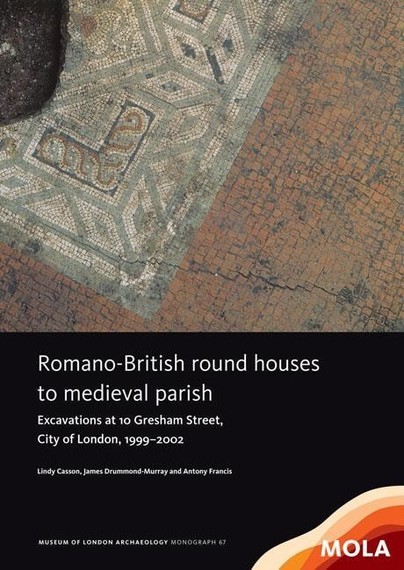
Format: Hardback
Pages: 250
ISBN: 9781907586224
Pub Date: 30 Apr 2014
Series: MoLAS Monograph
Illustrations: Fully colour illustrated
Description:
Good preservation in the western part of 10 Gresham Street has led to an unusually complete picture of the archaeological sequence.The discovery here of the largest group of Romano-British round houses yet excavated in London, clustered round a rectangular building, is of considerable significance for the Iron Age–Roman transition. Moreover, the site’s main north–south road seems to have been key to determining the layout of this whole area while evidence pointing to sporadic fires in the 2nd century AD casts new light on the idea of a single, catastrophic event.
Significant finds include a double gold finger ring of the 1st century AD, while close study of face pots and tazze leads to a rethinking of their possible ritual functions.Abandoned from the late 4th/early 5th century AD until the 10th century, by the 12th century the site boasted at least four masonry buildings. The remains of several rare and expensive glass display vessels found in a 13th-century refuse pit indicate the presence of an extremely affluent household. Later, two taverns stood on the site or very close by, and significant numbers of vessels for storing and serving ale and wine were recovered. Considerable truncation of post-medieval structures and deposits, however, means that only the deepest cellars and cesspits survived from that period.
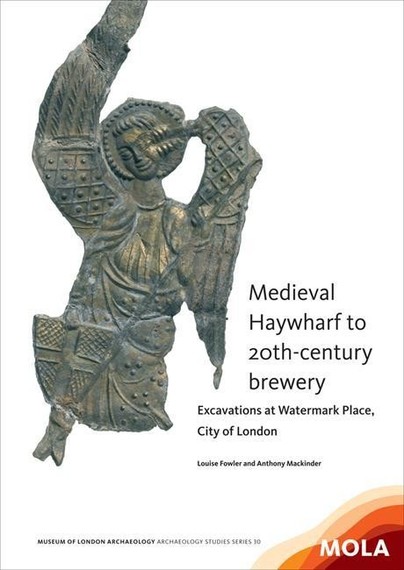
Format: Paperback
Pages: 150
ISBN: 9781907586231
Pub Date: 31 Mar 2014
Illustrations: Fully colour illustrated
Description:
Archaeological excavation by MOLA at Watermark Place in the City of London revealed evidence for the development of the city waterfront from the 13th century onwards. The remains of substantial and well-preserved timber river walls and timber/stone dock walls were recorded, and the use of tree-ring dating enabled the construction of one large timber river wall and dock to be dated to the year 1339. Many of the recorded structures related to the medieval wharf known as the Haywharf, probably originally so-named because it was where hay was imported into the city before c 1300.
In common with other excavations of medieval waterfronts in the City, the waterlogged deposits associated with the structural remains produced a remarkable array of finds, including over 700 accessioned finds. Large medieval foundations on the site probably relate to the mansion known as Coldharbour, which was constructed on the site by the early 14th century. Later remains included a sequence of 15th- to 16th-century industrial stone hearths or furnaces, and documentary evidence suggests that it is likely these were associated with either brewing or dyeing on the site. Also recorded were structures associated with the Calvert’s/City of London brewery, which stood on the site from the 18th century until it was bombed during World War II.
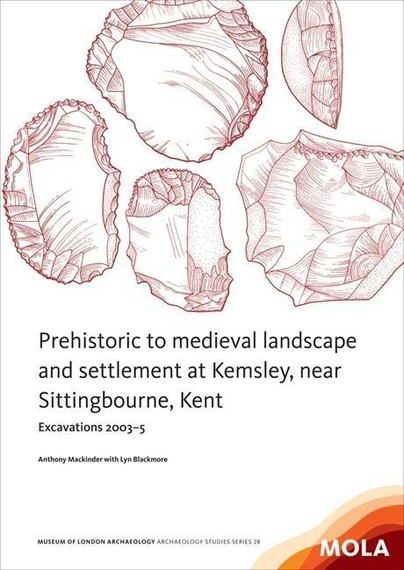
Format: Paperback
Pages: 100
ISBN: 9781907586217
Pub Date: 31 Jan 2014
Illustrations: Fully colour illustrated
Description:
This volume examines the evolution of a rural landscape in north Kent from the Late Mesolithic (c 7500 BC) to the 19th century, as revealed by analysis of the results of excavation on a site overlooking the marshes and tributaries of the River Medway, near Sittingbourne. Particular emphasis is placed on the prehistoric pottery assemblage and on understanding the site in terms of local and regional developments. Slight evidence for Late Mesolithic and Neolithic activity (residual finds only) was followed by the creation of a field system.
This was well established by the Late Bronze Age, when pitting and refuse disposal suggests the presence of a nearby settlement. There are inconclusive indications from associated pottery that some field boundaries may have had Middle Bronze Age origins and that some structured deposition was taking place. A period of abandonment, possibly related to rising sea levels, preceded the construction of a Middle Iron Age unenclosed farmstead represented by four roundhouses constructed at some time after c 300 BC and the re-establishment of a field system. The local field boundaries were reorganised in the Late Iron Age, and remained in use during the 1st century AD, but were abandoned thereafter, with no archaeological evidence for subsequent land use until a new farm was established in the 11th to mid 13th centuries.
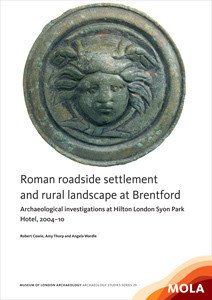
Format: Paperback
Pages: 110
ISBN: 9781907586194
Pub Date: 30 Sep 2013
Series: MoLAS Archaeology Studies Series
Description:
Excavations in Syon Park, Brentford, have made a substantial contribution to our knowledge of this Roman rural settlement on the London–Silchester road, by a ford across the Thames. The site yielded a well-dated sequence – from the mid 1st to early 5th century AD – including occupation deposits and two 2nd-century timber buildings destroyed by fire, as well as details of the main road and adjacent field system. These and a large assemblage of finds, including a surgical instrument and a roundel depicting the Medusa, provide a rare glimpse of life in the countryside in the hinterland of Londinium.
A detailed overview of Roman Brentford (the first to be published since 1978) is included.
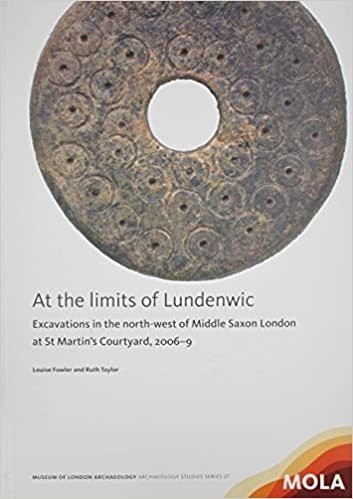
Format: Paperback
Pages: 90
ISBN: 9781907586187
Pub Date: 31 Aug 2013
Series: MoLAS Archaeology Studies Series
Description:
This thought-provoking volume presents the results of the archaeological investigation of a large site in Lundenwic. A fragmentary sequence nevertheless includes possible Early Saxon activity, 7th- and 8th-century settlement features including a cookshop, a workshop for non-ferrous metalworking and debris from a smithy, and the latest radiocarbon-dated inhumation in Lundenwic (cal AD 720–950). These excavations have made important contributions to our understanding of Lundenwic, which has been enhanced by the unprecedented level of organic preservation at the site.
The resulting survival of Saxon footwear, timber objects and uncharred botanical remains adds unusual detail to this publication.
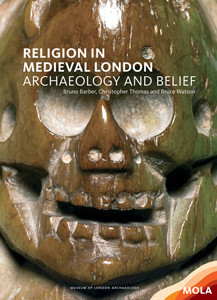
Format: Paperback
Pages: 100
ISBN: 9781907586071
Pub Date: 22 Aug 2013
Description:
Religious belief was central to the lives - and deaths - of all medieval Londoners. Religion was fully integrated into the social and political order, providing the population with an understanding of their place in the world and inspiring artists, architects and craftspeople. Belief motivated progressive acts such as early forms of social provision and medical care but was also used to justify wars of conquest and the brutal repression of diversity.
Archaeology sheds light on many aspects of belief: from organised religion, both Christianity and Judaism, to superstition or witchcraft; places of worship from the smallest parish churches to the great Cathedral of St Paul; tiny objects of personal devotion to entire monastic landscapes. Monasteries include communities cut off from the world, hospitals providing for London's poor or the headquarters of military religious orders behind the Crusades. Cemetery excavations reveal how Londoners responded to mortality both individually and together in the face of catastrophes such as the Black Death, while the events of the Reformation dramatically transformed both institutions and beliefs. This fully illustrated book provides an introduction to the evidence of belief from the Museum of London's archaeological excavations in the capital, with a particular focus on the programme of work, supported by English Heritage, on the sites of many of London's monasteries.
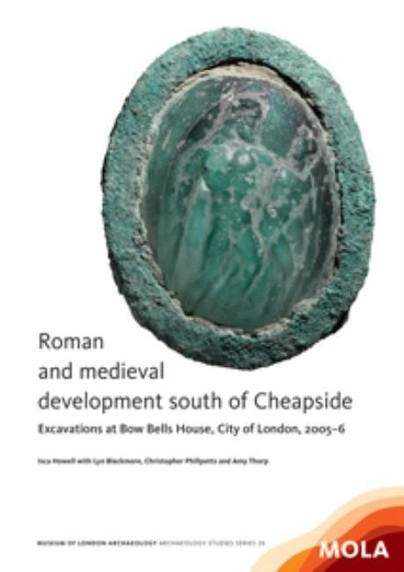
Format: Paperback
Pages: 120
ISBN: 9781907586170
Pub Date: 30 Jun 2013
Series: MoLAS Archaeology Studies Series
Description:
Excavations on the south side of Cheapside found evidence for Roman timber buildings and pits dating to the later 1st and 2nd centuries AD, and a masonry building constructed after c AD 125. The main west–east road through Londinium lay immediately north of the site. Evidence for later Roman occupation was limited by modern truncation.
No medieval ground surfaces survive, but the site was reoccupied from the 10th century with at least one substantial building existing by the 13th century. Pit and well groups include late 13th- or early 14th-century vessels associated with the wine trade and early 14th-century kitchenware.
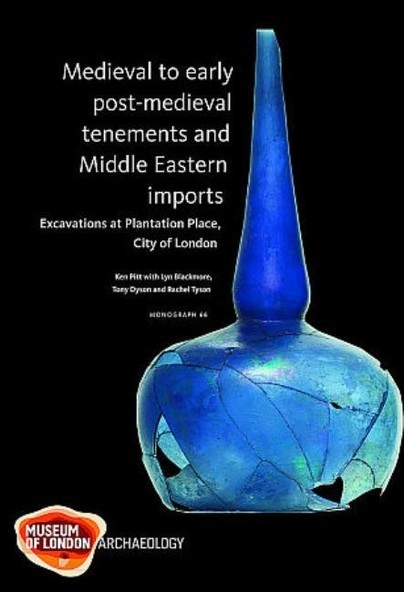
Format: Hardback
Pages: 140
ISBN: 9781907586163
Pub Date: 30 Apr 2013
Series: Monograph Series
Description:
Excavations at Plantation Place provided evidence for medieval and early post-medieval occupation of an entire block in the eastern part of the City of London near the Thames waterfront. Contemporary ground surfaces and buildings did not survive, but associated pits and wells have been related by documentary and cartographic research to identified tenements in this thriving area of shops, warehouses and merchants’ residences. Important assemblages from pits and wells include vessels used in refining gold, crucibles and moulds from bronze casting, and the largest assemblage of late medieval Islamic-style glass yet found in Britain, alongside Middle Eastern ceramics.
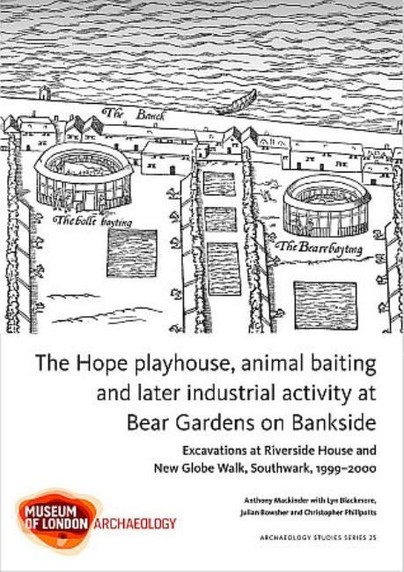
Format: Paperback
Pages: 94
ISBN: 9781907586200
Pub Date: 31 Mar 2013
Series: MoLAS Archaeology Studies Series
Description:
Southwark’s famous Bankside was long known as an entertainment area up to the 17th century. This volume provides evidence for the Barge, one of the medieval stewhouses (tavern/brothel) and the later Hope, a dual purpose building hosting animal baiting as well as play performances. The next phase in Bankside’s history was industrial and its glass and pottery products of the 17th and 18th centuries were much sought after.
Evidence for their production was found on the sites. The remains of 19th-century brick buildings relate to a known iron foundry in the area.
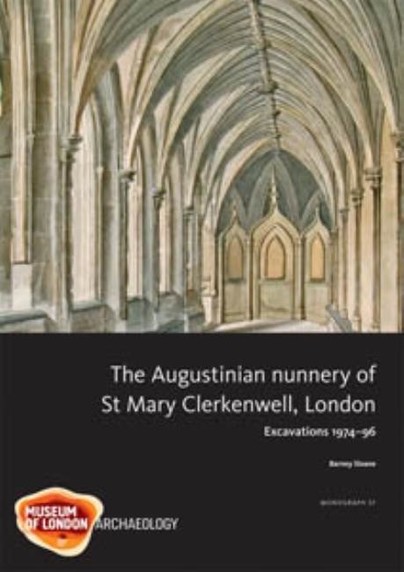
Format: Hardback
Pages: 300
ISBN: 9781901992045
Pub Date: 29 Jan 2013
Series: MoLAS Monograph
Description:
The development of the nunnery site is revealed in this study - from evidence for Iron Age occupation, the nunnery's foundation in 1144 and the expansion of the early convent, through to its conversion in the 16th and 17th centuries to a close of large mansions surrounding the parish church. Drawing together the varied evidence, including illustrations made during the demolition of the nunnery church in 1788-9 and 18th-century surveys, has allowed detailed reconstructions of the church and cloister. Relatively wealthy, located in Londons medieval suburbs and with a dual role as convent and parish church, St Marys story contrasts with that of many other, poorer and more rural, nunneries.
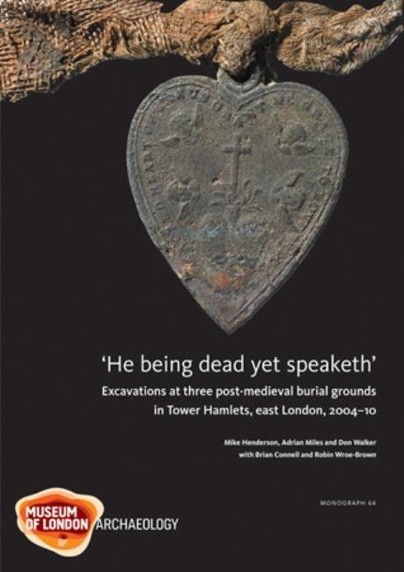
Format: Hardback
Pages: 370
ISBN: 9781907586156
Pub Date: 30 Nov 2012
Series: MoLAS Monograph
Description:
The latest in a series on post-medieval burial produced by MOLA, this volume reports on three non-Church of England burial grounds in the London Borough of Tower Hamlets, excavated between 2004 and 2010. It looks at over 1350 burials of Baptists, Roman Catholics and Nonconformists, the majority of whom died in 1820-54, and examines the archaeological and osteological evidence, along with the historical and documentary sources. The discussions aim to place the three populations within the wider context of 19th-century London and Britain, with the findings well illustrated and fully tabulated throughout.
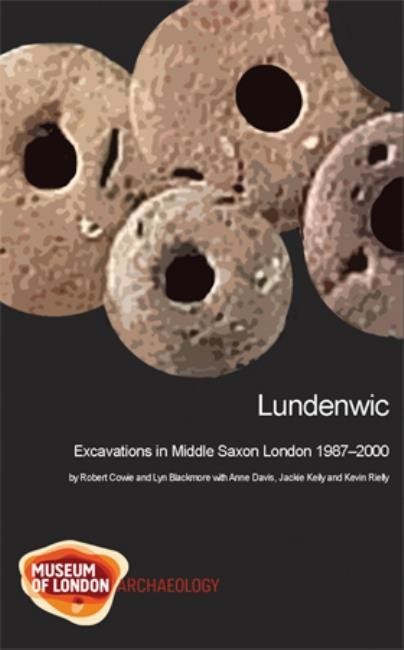
Format: Hardback
Pages: 350
ISBN: 9781907586149
Pub Date: 31 Oct 2012
Series: MoLAS Monograph
Description:
The development of the major settlement of Lundenwic in the late 7th century AD marked the rebirth of London as a town. In the following century the emporium served as a seaport for the landlocked kingdom of Mercia and played a significant role in the maritime trade of north-west Europe. This monograph provides the first detailed overview of the archaeological evidence for the trading port, placing it in its regional, national and international context.
The results of fieldwork at 18 locations on the site of the former Middle Saxon settlement are followed by essays on various aspects of the settlement, including its geographical setting, activity pre-dating Lundenwic (which includes one or more cemeteries), the development, size and layout of the emporium, food production and consumption, crafts and industry, trade, dress and religion. The final section focuses on finds assemblages recovered from the settlement, including ceramics, glass, metal, and bone and antler artefacts, as well as human, animal and plant remains. Radiocarbon dates interpreted by Bayesian modelling are found to broadly accord with archaeological evidence for rapid settlement growth in the third quarter of the 7th century AD, and the first use of Ipswich ware (an important chronological marker) in London c AD 730. The volume also includes a gazetteer of sites and a timeline for the settlement and its hinterland.

Format: Hardback
Pages: 290
ISBN: 9781907586101
Pub Date: 30 Jul 2012
Series: MoLAS Monograph
Description:
This book is designed to appeal to students and practitioners of osteology and palaeopathology, medical historians and forensic archaeologists; it can be used as a reference guide in the field and the laboratory. Human health affects all aspects of everyday life and skeletal remains represent direct evidence of the experiences of people in the past. This volume describes human skeletal remains from archaeological excavations in London, ranging from the Roman period to the 19th century.
It includes more than 400 photographic and radiographic images of disease and traumatic injury, providing a unique opportunity to explore the lives of past communities.
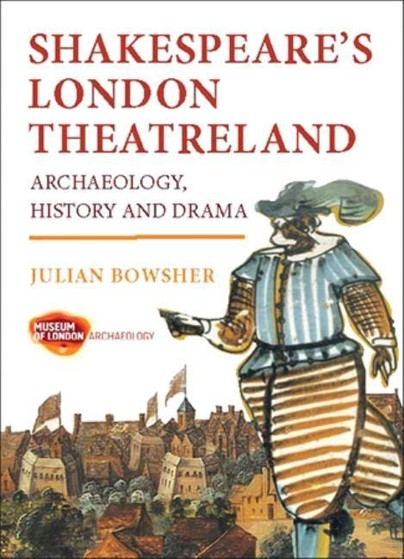
Format: Paperback
Pages: 250
ISBN: 9781907586125
Pub Date: 30 Jul 2012
Description:
This guide to the unique theatrical venues of London, from 1567, when the first playhouse was built, to 1642, when Cromwell closed them down, sets out the rich dramatic history of this period in relation to the latest exciting archaeological evidence. The book also details the people involved - the builders, actors, playwrights and audiences - what they wore and what they ate, where they drank, where they fought, where they lived and died. There are theatrical quotes and jokes, and illustrations old and new, while a series of walks explores different areas of today's London, where glimpses of Shakespeare's London can still be caught.


















